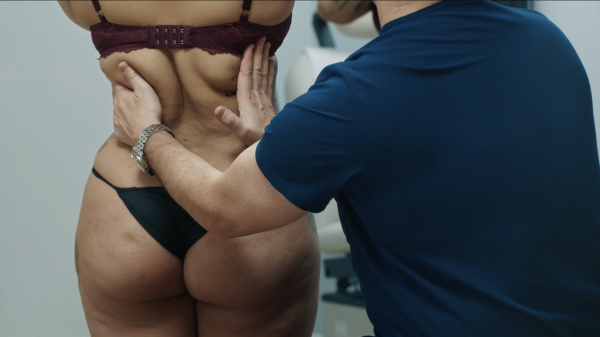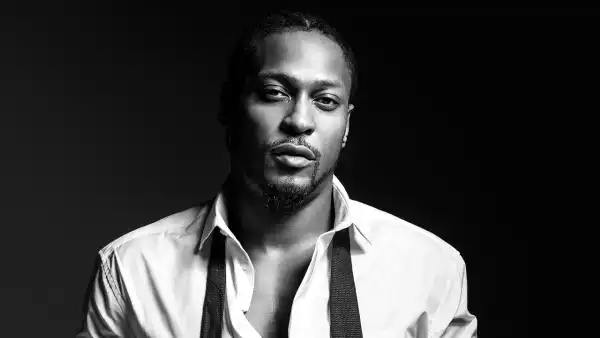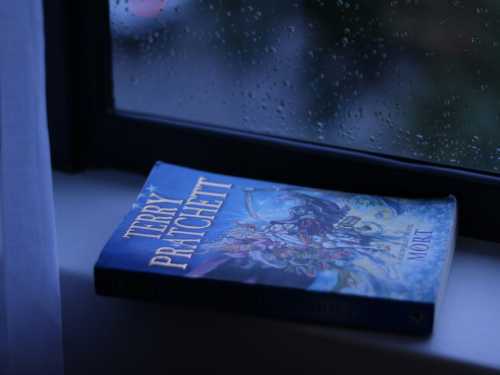
There’s no shortage today of moralizing around plastic surgery, but “You’ll Be Happier” feels more invested in closely observing one woman’s experience.
“I want to like myself more,” a woman says, in voice-over. On the screen, doctors in masks and plastic gloves mill around her unconscious body. “More than I already like myself,” she continues. “Because I absolutely love myself. But I just want . . . more.” This is the opening scene of “You’ll Be Happier” (2023), a new documentary by the director Daniel Lombroso. The film follows a young woman, Jennifer, through her Brazilian-butt-lift procedure, a complex, hours-long operation that transfers fat from the stomach, arm, or back to the gluteal area. Lombroso depicts Jennifer before and during the surgery, as well as at different points along the arc of her recovery. Through intimate conversations with her doctor, her sister, and her fiancé, Ian, Jennifer describes how she hopes the procedure will change not just her physique but her relationship to herself.
When a B.B.L. goes well, the healing process, which some patients have said is more painful than childbirth, can take weeks or months. When it doesn’t—if, for example, lipids are injected into the bloodstream and pushed into the heart or lungs—it can result in death. Yet B.B.L.s have “grown as fast as any other cosmetic procedure in recent memory,” according to the Times. Every patient brings her own history to the operating table, and Lombroso carefully examines the context for Jennifer’s choice. Her butt-lift will cost fifteen thousand dollars—money her parents urge her to put toward a down payment on a condo—but she’s excited for a makeover, someone “to sculpt my body the way I want.” She has already undergone cosmetic procedures, including liposuction and one prior Brazilian butt-lift she wasn’t happy with. (Her skin is blanketed, also, in delicate and feminine tattoos: an octopus sprawling down her side, a butterfly at her hip, roses and vines on her forearm, an anime panda above her thigh.) And she has childhood demons to exorcise. Growing up, Jennifer says, she felt “horrible because my sisters were very thin and pretty, and then I’m just . . . there.” She remembers exercising until she passed out, how her parents would call her a cow. As Jennifer speaks, an old photograph fills the screen—three sisters in fairy wings and crowns, their forms indistinguishable, at least to this viewer. (“Sometimes when I’m making movies,” Lombroso told me, “I’ll play the person’s subjective narrative up against archive. I think it can be really interesting.”)
The New Yorker Documentary
View the latest or submit your own film.

Lombroso’s interest in exploring plastic surgery in a documentary came from his own childhood memories. His mom used to drive him around their neighborhood in New Rochelle, New York, and talk about the pressures of being a woman: she never had cosmetic surgery, but she could sense that she was being judged differently as she aged. Years later, he noticed the trend of doctors and patients documenting plastic surgeries on social media. He was fascinated by the “need to be seen” that was seemingly being expressed, but it was hard to know how to represent that impulse on film. He wanted to find a nuanced and empathetic tone—to show that he didn’t have all the answers. (He cast aside “You’ll Be Happier” ’s first title, “Skin Deep,” because it implied that Jennifer’s pursuit of cosmetic enhancement was superficial.) When Lombroso first learned about the B.B.L., he was “blown away” by both the risks and costs of the procedure; he was equally affected by how many women were documenting their procedures on social media, crafting personal brands around their body-modification journeys. There was a deeper story to be told, he felt, about the way realness was constructed—both on Instagram and on the operating table. A taboo against plastic surgery seemed finally to have lifted—would women be any happier?
The first step in creating the film was finding a doctor who wouldn’t balk at a camera in his operating room. Enter Dr. Matthew Schulman, of the Upper East Side, who has live-streamed his B.B.L. surgeries on Snapchat. (Schulman also posts images of pre-op patients under the Instagram handle @realdrschulman, with captions like: “Another lucky woman joining the Big Booty Club. She wants big, so we won’t be holding back today.”) Through Schulman, Lombroso met and spoke to two prospective patients. One, a medical resident at Mount Sinai, was thoughtful and charismatic, but she was on the fence about being filmed, and Lombroso didn’t want to be in a position of pressuring her. Jennifer, though, was captivating, funny, certain of what she wanted, and unafraid of sharing her story—or being naked on camera. If someone could learn from her journey, she told Lombroso, then that’s a good thing.
In the film, we see Jennifer, a day out from her surgery, shot against a bare wall. She cleans and files and rubs and soaks her nails. She hovers at the mirror, patting her cheeks and pursing her lips—not preening, concentrating, her expression abstract and a little sad. Watching Jennifer undergo the fat transplant is harrowing. (Lombroso presented the O.R. footage without any additional soundtrack, to better convey the surgery’s violence.) But it’s not that much more harrowing than watching Jennifer struggle to reconcile her B.B.L. with popular feminist scripts. In one scene, she views a graphic video of her surgery with her sister and fiancé. “Like, do I love myself or do I hate myself?” she asks them. “I can’t tell what it is.” If Lombroso’s documentary is about the emergence of a fresh set of unforgiving beauty standards to live up to, it is also about the contortions that women must put themselves through to telegraph self-love while pursuing those standards.
There’s no shortage today of moralizing around plastic surgery, but “You’ll Be Happier” feels more invested in closely observing one woman’s experience. Lombroso hoped to unsettle, rather than reinforce, cultural pieties: the presence of a pregnant character, for instance, stirs up questions about which extreme and dangerous body modifications get normalized and approved of, and why. Above all, Lombroso wanted to portray Jennifer with sensitivity and depth. She comes across, onscreen, as by turns deluded and wise, passive and brave. The surprisingly high stakes of the documentary are her happiness, with the viewer not so much wondering whether a B.B.L. will fulfill her as hungering for the world in which it could. It would be nice if the relocation of some fat deposits gave this already attractive young woman a sustained feeling of beauty.
As in his documentary “White Noise,” from 2020, Lombroso is interested in the on- and offscreen lives of media-makers. “I love the moment after people cut [the camera],” he told me. A scene in “You’ll Be Happier” shows Dr. Schulman filming an informational video about breast implants for social media. He twists and bites a glob of silicon to demonstrate its indestructibility. When the take is finished, he stands there awkwardly playing with the artificial boob. It’s a light moment, but it rhymes with another, later scene in which a post-op Jennifer assesses how she feels about her new butt. “It looks way better,” she says. The camera zooms toward her face—she’s glowing. “I feel like I got . . . not a new life but just seeing myself differently, just seeing how far I’ve grown—” She smiles and giggles. “It feels really good!” She’s so radiant and open that the viewer feels good, too, and desperate for the euphoria to last. The camera stays on Jennifer, and she holds the pose, her smile gently growing fainter. Finally, she nods as if to indicate that the shot is over. ♦
Sourse: newyorker.com






